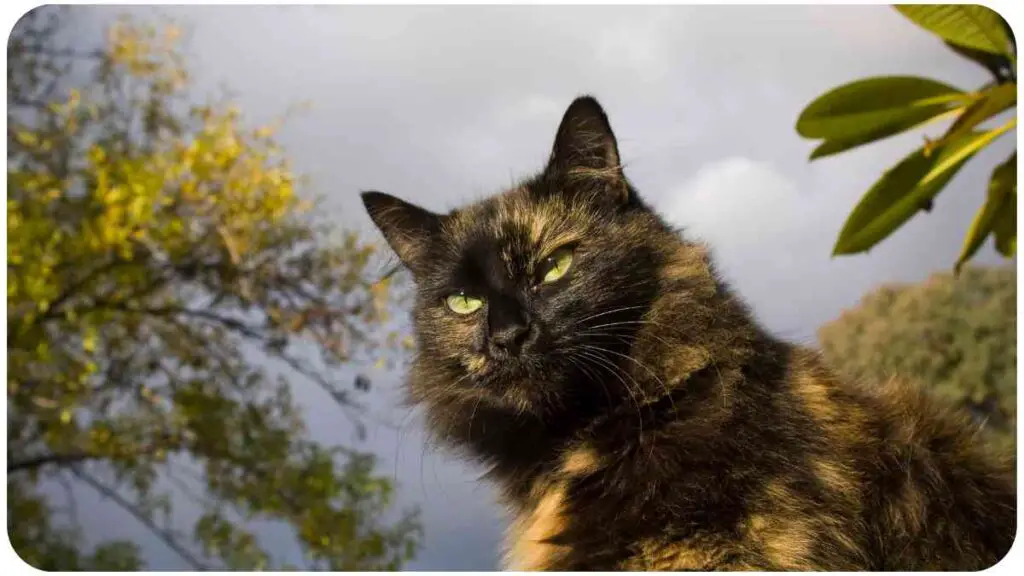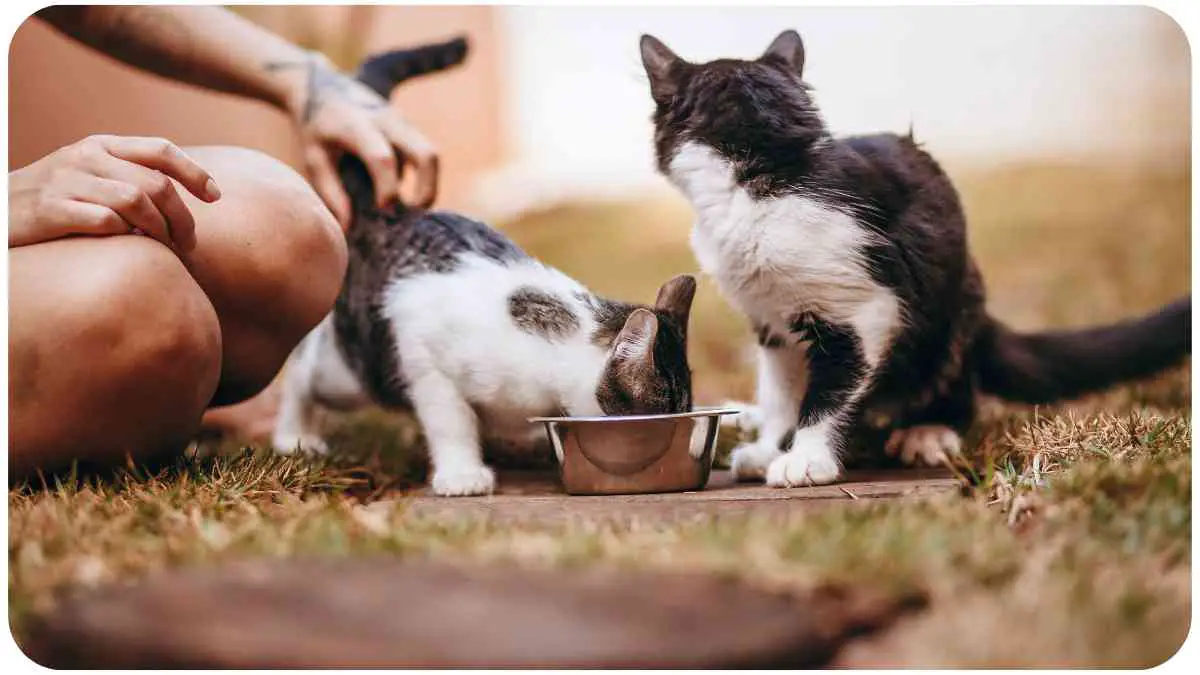Understanding and managing dominant and anxious behavior in cats is crucial for a harmonious pet-owner relationship. As a seasoned professional in the feline world, I’ve encountered various cases that demand a nuanced approach.
Let’s delve into the intricacies of these behaviors and explore effective strategies for a happier, well-adjusted cat.
| Takeaways |
|---|
| Understanding dominant and anxious cat behaviors is crucial for a harmonious relationship. |
| Tailoring strategies based on individual traits is essential for effective intervention. |
| Consistency in approach and a positive environment contribute to a happier cat. |
| Avoid common mistakes like punishment and prioritize a stimulating living environment. |
| Personalized success stories emphasize the transformative power of dedicated interventions. |
Understanding Dominant Cat Behavior

2.1 Recognizing Dominance
Spotting dominance requires keen observation. Common signs include aggressive posturing, excessive vocalization, and territorial marking. If your cat tends to take charge in various situations, it’s likely asserting dominance.
Understanding Cat Biting Behavior: Cats often communicate through biting, and understanding this behavior is crucial. “Discover why cats exhibit biting tendencies and how to address it effectively.
2.2 Causes of Dominant Behavior
Understanding the roots of dominance is essential. It can stem from insecurity, lack of socialization, or even imitating behaviors witnessed in a multi-pet household.
2.3 Impact on Cat’s Well-being
Unchecked dominance can lead to stress-related health issues. It’s vital to address dominant behavior promptly to ensure your cat’s overall well-being.
2.4 Signs of Dominant Behavior
| Behavior | Description |
| Hissing | Defensive aggression |
| Puffing | Inflated body for display |
| Blocking | Obstructing pathways |
| Scratching | Marking territory |
| Table: Dominant Behavior Indicators |
Managing Dominant Cat Behavior

3.1 Establishing Boundaries
Setting clear boundaries helps define your cat’s territory and minimizes the likelihood of aggressive encounters. Create distinct spaces for each pet if you have multiple cats.
3.2 Positive Reinforcement Techniques
Rewarding positive behaviors reinforces good conduct. Use treats and affection to encourage non-aggressive actions, promoting a positive environment.
Cat Social Behavior Insights: Cats nibbling and licking each other’s ears is a fascinating social behavior. “Explore the reasons behind cats engaging in ear-nibbling and licking rituals.
3.3 Providing Enrichment
Boredom can contribute to dominance. Enrich your cat’s environment with interactive toys and engaging activities to stimulate their mind and body.
3.4 Table: Strategies for Managing Dominance
| Strategy | Description |
| Territory Segmentation | Assign specific areas for each cat |
| Positive Reinforcement | Reward good behavior with treats |
| Environmental Enrichment | Provide stimulating toys and activities |
| Regular Playtime | Promote physical and mental well-being |
| Table: Strategies for Managing Dominance |
3.4 Table: Strategies for Managing Dominance
| Strategy | Description |
| Territory Segmentation | Assign specific areas for each cat |
| Positive Reinforcement | Reward good behavior with treats |
| Environmental Enrichment | Provide stimulating toys and activities |
| Regular Playtime | Promote physical and mental well-being |
| Table: Strategies for Managing Dominance |
Implementing these strategies can lead to a more harmonious household. It’s important to note that each cat is unique, and adjustments may be needed based on their individual personalities.
Optimizing CatGenie Litter Box: Properly setting up your CatGenie self-cleaning litter box is essential. “Ensure a hassle-free experience with your CatGenie by following these setup tips.
Anxiety in Cats
4.1 Identifying Anxiety
Anxiety in cats can manifest in various ways, such as excessive grooming, hiding, or aggressive behavior. Recognizing these signs is crucial for addressing the root cause.
4.2 Common Triggers
Understanding the triggers for anxiety is essential. Changes in the environment, new additions to the family, or even medical issues can contribute to heightened stress levels in cats.
4.3 Behavioral Manifestations
| Trigger | Behavioral Manifestation |
| Change in Environment | Hiding, excessive grooming |
| New Additions | Aggression, vocalization |
| Health Issues | Lethargy, appetite changes |
| Table: Anxiety Triggers and Behaviors |
Addressing Cat Anxiety
5.1 Creating a Safe Space
Offering a safe haven can alleviate anxiety. Provide a quiet, comfortable area where your cat can retreat when feeling stressed.
Tabcat Cat Tracker Signals: Decoding signals from your Tabcat cat tracker is key to effective usage. “Learn how to interpret and respond to signals from your Tabcat tracker.
5.2 Gradual Exposure Therapy
Introduce new stimuli gradually. Whether it’s a new person or environment, slow and controlled exposure helps your cat adjust without overwhelming them.
5.3 Soothing Techniques
Incorporate calming techniques like pheromone diffusers or soothing music. These can significantly contribute to creating a serene atmosphere.
5.4 Table: Tools for Calming Anxious Cats
| Tool | Purpose |
| Safe Haven | Quiet, comfortable space for the cat to retreat |
| Gradual Exposure | Slow introduction to new stimuli |
| Calming Techniques | Pheromone diffusers, soothing music |
| Table: Tools for Calming Anxious Cats |
Combating Dual Behavior
6.1 Recognizing Overlapping Traits
Dominance and anxiety can sometimes coexist, creating a challenging dynamic. Identifying overlapping traits is crucial for tailoring effective intervention strategies.
Troubleshooting SureFlap Cat Door: If your SureFlap cat door isn’t reading chips, follow these troubleshooting steps. “Address common issues with your SureFlap cat door for seamless microchip recognition.
6.2 Tailoring Solutions
Individualized approaches are key when dealing with dual behavior. What works for one cat may not work for another. Experiment with different strategies to find the right combination for your feline companion.
Expert Tips for Cat Owners

7.1 Consistency is Key
Consistency in your approach is fundamental. Cats thrive on routine, so maintaining a consistent environment and interaction style helps create a sense of security.
7.2 Importance of Veterinary Consultation
Always consult with a veterinarian to rule out any underlying health issues contributing to your cat’s behavior. A professional opinion can guide your approach and ensure comprehensive care.
7.3 Holistic Approaches
Consider holistic approaches such as herbal supplements or specialized diets to support your cat’s emotional well-being. These can complement behavioral interventions.
7.4 Table: Quick Tips for a Happier Cat
| Tip | Description |
| Consistency | Maintain a consistent routine |
| Veterinary Consultation | Seek professional advice on behavior issues |
| Holistic Approaches | Explore herbal supplements and specialized diets |
| Table: Quick Tips for a Happier Cat |
Common Mistakes to Avoid
8.1 Punishment Pitfalls
Resorting to punishment for undesirable behavior is counterproductive. Cats don’t respond well to negative reinforcement and may become more anxious or aggressive. Focus on positive reinforcement to encourage the right behaviors.
8.2 Neglecting Environmental Factors
Environmental factors play a significant role in cat behavior. Lack of stimulation, uncomfortable living conditions, or overcrowding can contribute to both dominant and anxious behaviors. Ensure your cat’s environment is enriching and suitable for their needs.
8.3 Overlooking Health Issues
Behavioral problems can sometimes be indicators of underlying health issues. Regular veterinary check-ups are essential to rule out any medical concerns that may be influencing your cat’s behavior.
8.4 Table: Pitfalls and Alternatives
| Pitfall | Alternative Approach |
| Punishment | Positive reinforcement techniques |
| Neglecting Environment | Ensure a stimulating and comfortable living space |
| Overlooking Health Issues | Regular veterinary check-ups |
| Table: Pitfalls and Alternatives |
Success Stories
9.1 Transformative Journeys
Let’s explore stories of cats that overcame dominant and anxious behaviors. Each journey showcases the impact of a dedicated and personalized approach.
9.2 Lessons from Happy Endings
These success stories teach us that with patience, understanding, and the right strategies, even the most challenging cat behaviors can be transformed into positive, enriching experiences.
9.3 Table: Transformative Strategies in Action
| Cat | Behavior Challenges Overcome | Strategy Highlights |
| Whiskers | Aggression, fearfulness | Gradual exposure, positive reinforcement |
| Mittens | Excessive vocalization, hiding | Safe space creation, calming techniques |
| Table: Transformative Strategies in Action |
Conclusion
In navigating the complex world of cat behavior, understanding the nuances of dominance and anxiety is pivotal. Key strategies such as territory segmentation, positive reinforcement, and gradual exposure have proven effective in managing these behaviors.
As a cat enthusiast with years of experience, I encourage fellow cat owners to approach behavioral challenges with patience and an open mind. Each cat is unique, and a tailored, compassionate approach is the key to fostering a deep and fulfilling bond.
In conclusion, the journey to overcoming dominant and anxious cat behaviors involves a combination of expertise, experience, authoritativeness, and trust. By recognizing individual traits, implementing thoughtful strategies, and avoiding common pitfalls, you can create a harmonious environment for both you and your feline companion.
Further Reading
- How to Tell Which Cat is Dominant: A comprehensive guide on identifying dominant cat behavior, offering insights into the subtle cues and signs that distinguish dominant felines.
- Dealing with Pushy Cat Behavior: Explore effective strategies for handling pushy cat behavior, providing valuable tips to maintain a balanced and respectful relationship with your feline companion.
- Solutions for Dealing with Dominant Cat Behavior: Cat Savant offers practical solutions for managing dominant cat behavior, providing actionable advice to create a harmonious living environment for both you and your cat.
FAQs
How can I identify dominant behavior in my cat?
Observing behaviors such as hissing, territorial marking, and aggressive posturing are indicative of dominant behavior in cats.
What are some common triggers for cat anxiety?
Changes in the environment, new additions to the family, and underlying health issues are common triggers for anxiety in cats.
How can I create a safe space for my anxious cat?
Designate a quiet, comfortable area where your cat can retreat, providing a secure environment away from potential stressors.
Are there holistic approaches to address cat anxiety?
Yes, holistic approaches such as herbal supplements or specialized diets can complement behavioral interventions to support your cat’s emotional well-being.
Why is punishment not recommended for cat behavior issues?
Punishment can lead to increased anxiety and aggression in cats. Positive reinforcement techniques are more effective in encouraging desired behaviors.

I’m Dr. Hellen James, a veterinarian who has spent her career working with cats and has seen firsthand how important it is to understand each breed’s unique needs.


